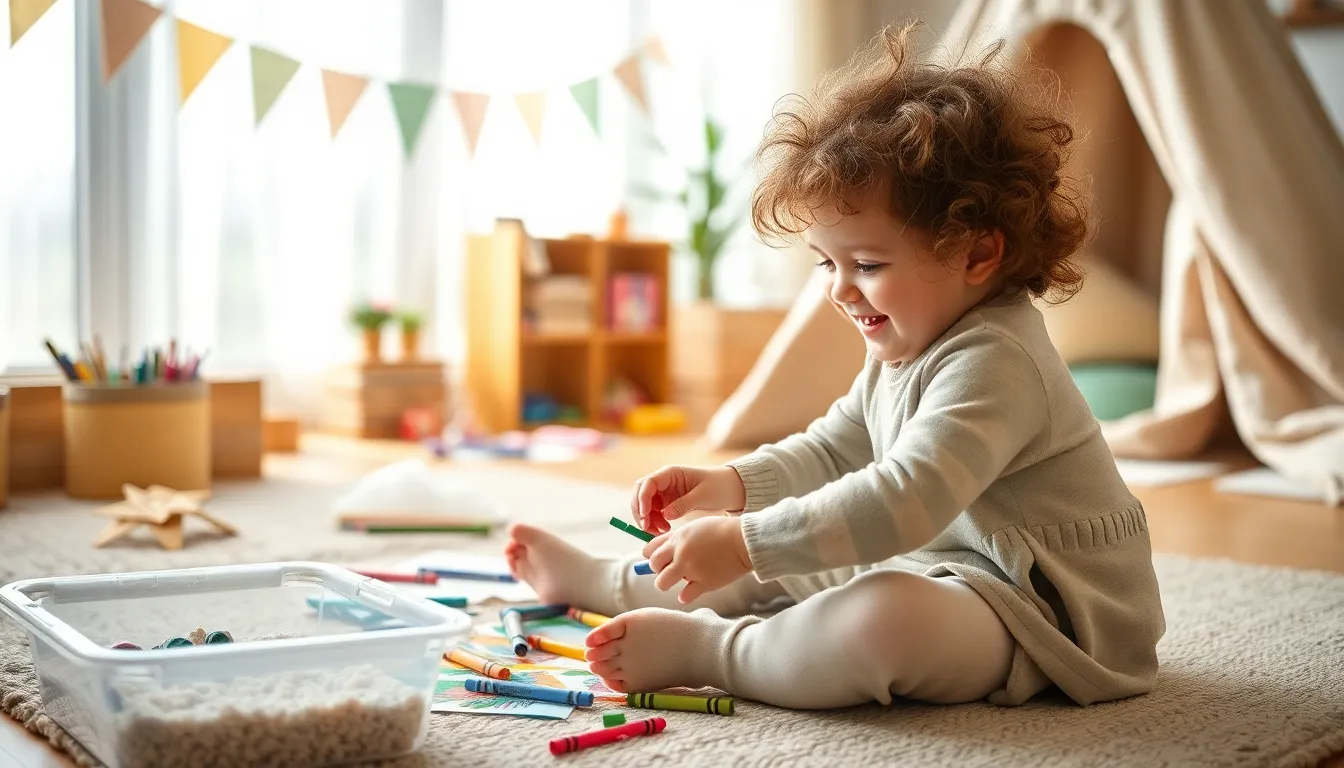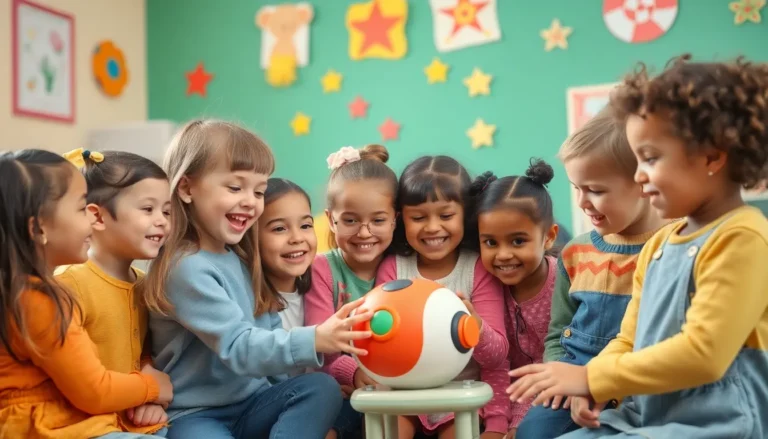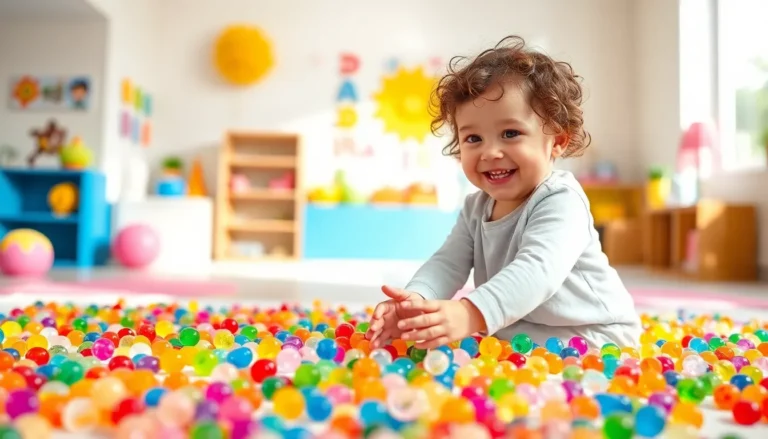Table of Contents
ToggleWhen the weather outside is frightful and your little one’s energy is delightful, finding indoor activities for toddlers becomes a quest worthy of a superhero. Parents know that a bored toddler can turn a peaceful living room into a chaotic play zone faster than you can say “time-out.” But fear not! With a sprinkle of creativity and a dash of patience, the indoors can transform into an adventure land filled with laughter and learning.
Imagine building a fort that rivals the best castles in the kingdom or conducting a mini science experiment that leaves everyone in awe. These activities not only keep toddlers entertained but also spark their imagination and development. So grab your cape and get ready to dive into a world of fun-filled indoor activities that will have your tiny tornado engaged and you smiling, all while avoiding the dreaded “I’m bored!” chorus.
Benefits Of Indoor Activities For Toddlers
Indoor activities offer significant benefits for toddlers’ overall growth. These activities foster their physical and cognitive development.
Physical Development
Engaging in indoor activities promotes physical skills. Climbing over cushions or crawling through tunnels enhances strength and coordination. Simple activities like dancing to music or playing ball games support gross motor skills. Fine motor skills improve through tasks such as building with blocks or threading beads. Daily movement keeps toddlers active and encourages healthy habits. Frequent physical engagement counteracts sedentary behavior, reducing risks of obesity. Indoor play increases stamina and agility, benefiting their long-term physical health.
Cognitive Development
Indoor activities stimulate cognitive skills in toddlers. Creative play, such as art projects, enhances problem-solving abilities and imagination. Interactive games build memory and concentration as toddlers follow rules and remember turns. Reading together introduces new vocabulary and strengthens language skills. Science experiments spark curiosity, allowing toddlers to explore cause-and-effect relationships. Furthermore, activities that involve sorting or counting foster early numeracy skills. Frequent cognitive engagement lays a strong foundation for future learning.
Popular Indoor Activities For Toddlers

Engaging toddlers indoors requires creativity and a variety of activities. Below are some popular options that promote fun and learning.
Arts And Crafts
Arts and crafts provide opportunities for self-expression. Activities like finger painting, coloring, and crafting with recycled materials capture attention. Creating collages from magazines fosters creativity and enhances fine motor skills. Using child-safe scissors for cutting tasks strengthens coordination. Painting stones or wooden shapes welcomes exploration and imagination. It’s important to encourage sharing materials, which teaches cooperation and communication.
Sensory Play
Sensory play captivates toddlers by engaging their senses. Activities such as sensory bins filled with rice, beans, or pasta allow exploration through touch. Adding small toys to the mixture encourages imaginative scenarios. Water play with cups and sponges promotes motor skills while keeping toddlers entertained. Creating slime or playdough provides a tactile experience that sparks curiosity. When parents join in, they can enhance learning through discussions about textures and properties.
Imaginative Play
Imaginative play fosters creativity and problem-solving skills. Role-playing scenarios like a grocery store or doctor’s office stimulate their minds. Using puppets for storytelling encourages communication and interaction. Building forts with blankets and cushions allows children to create their own worlds. Dress-up activities enable exploring different personas and professions. Engaging in pretend play not only entertains but also develops social skills essential for future interactions.
Tips For Engaging Indoor Activities
Engaging toddlers in indoor activities requires creativity and variety. The right mix keeps them entertained while promoting development.
Keeping It Fun And Varied
Rotate activities frequently to maintain interest. Scheduled changes in projects like building blocks or art ensure novelty. Every new activity can introduce different themes, such as nature or space, sparking curiosity. Include props like puppets or costumes to enhance playtime. Outdoor elements, like using leaves or rocks for craft, create excitement. Frequent changes prevent monotony, enhancing toddlers’ willingness to explore.
Incorporating Learning Opportunities
Integrate educational elements into play. Counting objects during sorting games reinforces numeracy. Incorporate letters using magnetic tiles while building structures to boost literacy. Simple science experiments, such as mixing baking soda and vinegar, introduce basic chemistry concepts. Storytime discussions about characters develop conversation skills. Encourage questions to cultivate curiosity. Each moment has the potential to teach, making learning seamless and fun.
Safety Considerations
Safety plays a crucial role when planning indoor activities for toddlers. Parents can ensure a secure environment by taking necessary precautions.
Childproofing The Space
Childproofing the space safeguards toddlers during play. Secure heavy furniture to walls to prevent tipping. Cover electrical outlets with safety caps to eliminate risks of shocks. Remove small objects that pose choking hazards and store cleaning products in locked cabinets. Use soft materials for play areas to cushion falls. Creating a clutter-free environment enables safer movement and less distraction. Regularly inspect toys for wear or damage to maintain safety standards.
Choosing Age-Appropriate Activities
Choosing age-appropriate activities maximizes enjoyment and learning. Consider toddlers’ developmental stages when selecting play options. Simple puzzles and large building blocks foster fine motor skills. Arts and crafts like finger painting engage creativity while being safe. Look for toys designed for specific age groups to ensure safety and effectiveness. Activities should promote interaction and understanding without overwhelming toddlers. Introducing sensory play can stimulate curiosity and exploration, further supporting their growth. Ensuring activities match their abilities encourages confidence and enthusiasm.
Finding engaging indoor activities for toddlers can transform dreary days into opportunities for fun and learning. By fostering creativity and physical movement through imaginative play and hands-on projects, parents can support their child’s development in meaningful ways.
With a variety of activities to choose from, it’s easy to keep toddlers entertained while enhancing their cognitive and motor skills. Prioritizing safety and age-appropriate options ensures a secure environment for exploration.
Embracing these indoor activities not only keeps little ones happy but also lays the groundwork for lifelong learning and healthy habits. Parents can feel confident in their ability to create enriching experiences that nurture their child’s growth even when staying inside.








